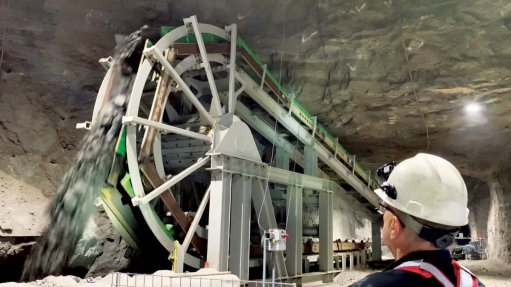
The Railveyor system is a fully electric and autonomous bulk material handling system.
Photo by: Railveyor
Electrifying the Elk Creek mine in south-west Nebraska could be a game changer for the critical minerals project, promising to not only reduce upfront capital and operational expenses, but also accelerate production timelines, says Nasdaq-listed NioCorp.
A scoping study completed by engineering firm Optimize Group suggests that electrifying the Elk Creek mine through a Railveyor system instead of using the currently planned vertical mining shafts will have economic and environmental benefits.
“The Optimize study hints at some very compelling potential benefits of this technology to NioCorp,” says NioCorp CEO and chairperson Mark Smith.
The Railveyor system is a fully electric and autonomous bulk materials handling system that delivers mined ore to processing facilities through a narrow-gauge light rail system propelled by low-horsepower drive stations adjacent to the rail route.
The Railveyor system is a “tried-and-true” technology that has been in operation for years in underground mines, adds NioCorp COO Scott Honan.
“NioCorp is examining this option very seriously and we do not anticipate that choosing this technology pathway will delay an update to the feasibility study for our Elk Creek critical minerals project,” he states.
The existing feasibility study shows full ore production at month 45 of the project. In contrast, the new twin ramp scenario could achieve full production at month 40, a saving of five months, owing to the simplification of predevelopment construction activities.
The initial capital expenditure (capex) could be reduced by 53% from $356 000 in the 2022 shaft scenario to $167 100 in the 2024 twin-ramp scenario. Total capital expenditure will be reduced by 31% to $381 800.
The design examined by Optimize removes the production shaft, ventilation shaft, and all materials handling infrastructure. The removed infrastructure is replaced with two ramps. Ramp 1 would be for all personnel and equipment movement, while Ramp 2 would be for the Railveyor haulage system.
”The beauty of the Railveyor system is its simple and rugged design,” says Honan.
“It is well suited to operate in the challenging environment of an underground mine, and can be easily operated and maintained by individuals with a basic underground mining skill set.”
According to Railveyor, the haulage system uses a train system with cars that will hold about 1.2 t of material. These cars differ from a traditional train system in as much as the cars connect to create a single long trough akin to a conveyor belt. This system allows for simple continuous loading like a conveyor system with the haulage flexibility of a train system.
In addition to the Railveyor system running on electricity, the new design would use battery-powered equipment instead of currently planned diesel-powered equipment, which the study found would significantly reduce emissions.